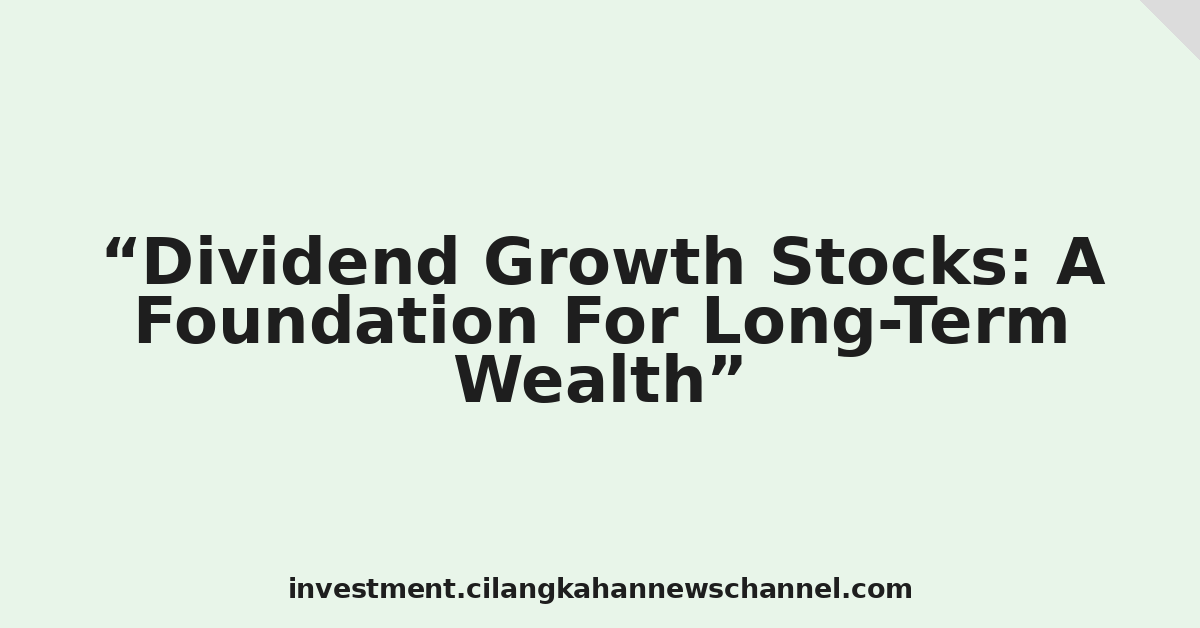Dividend growth investing is a powerful strategy for building long-term wealth. It focuses on companies that not only generate profits but also consistently increase their dividend payouts over time. This approach offers a compelling blend of capital appreciation and recurring income, making it attractive to both seasoned investors and those new to the market. Understanding the intricacies of dividend growth investing, however, requires a deeper dive into its principles, benefits, and inherent risks.
Hello readers of investment.cilangkahannewschannel.com! This article will serve as your comprehensive guide to navigating the world of dividend growth stocks. We’ll explore the key factors to consider when selecting these investments, discuss effective strategies for building a portfolio, and address potential pitfalls to avoid. By the end, you’ll possess a clearer understanding of how dividend growth stocks can contribute to your financial goals.
Understanding Dividend Growth Stocks:
At its core, a dividend growth stock represents a share in a company committed to steadily increasing its dividend payments to shareholders. This commitment reflects a company’s financial health, profitability, and confidence in its future prospects. Unlike companies that pay out a fixed dividend, or those that may sporadically distribute dividends, dividend growth companies prioritize consistent and increasing payouts, often mirroring the company’s overall growth trajectory.
Several factors contribute to a company’s ability to consistently increase its dividend. These include:
-
Strong and Sustainable Earnings Growth: A fundamental requirement for dividend growth is a robust and predictable earnings stream. Companies with consistent revenue growth and efficient operations are better positioned to fund increasing dividend payments without compromising their financial stability.
-
Low Debt Levels: High levels of debt can strain a company’s finances, limiting its capacity to invest in growth initiatives and maintain dividend payments. Companies with conservative debt strategies are generally more reliable dividend payers.
-
High Retention Ratio: The retention ratio represents the portion of earnings that a company retains for reinvestment in the business. A higher retention ratio can fuel future growth, ultimately supporting further dividend increases.
-
Strong Free Cash Flow: Free cash flow (FCF) is the cash generated by a company’s operations after accounting for capital expenditures. A healthy FCF is crucial for funding dividends and reinvestment opportunities.
-
Management’s Commitment to Shareholders: Companies with a proven track record of prioritizing shareholder returns, including consistent dividend growth, are generally more attractive to dividend growth investors.
The Benefits of Dividend Growth Investing:
The appeal of dividend growth stocks stems from a combination of benefits:
-
Recurring Income Stream: Dividend payments provide a regular stream of income, supplementing other income sources and potentially accelerating the growth of your investment portfolio.
-
Capital Appreciation: While dividend income is a significant advantage, dividend growth stocks often also appreciate in value over time, further enhancing returns. Companies that consistently increase their dividends tend to be viewed favorably by the market, leading to higher stock prices.
-
Inflation Hedge: Dividend payments, particularly from well-established companies, can provide a degree of protection against inflation. As inflation rises, companies often adjust their dividend payouts to maintain their real value.
-
Reduced Portfolio Volatility: While no investment is entirely risk-free, dividend growth stocks can offer a degree of stability compared to other asset classes. The consistent income stream can help cushion the impact of market fluctuations.
-
Long-Term Wealth Building: The combination of dividend income and capital appreciation makes dividend growth investing a powerful tool for long-term wealth creation. The compounding effect of reinvesting dividends can significantly accelerate portfolio growth over time.
Strategies for Building a Dividend Growth Portfolio:
Building a successful dividend growth portfolio requires a well-defined strategy:
-
Diversification: Diversifying across multiple sectors and companies reduces risk. Don’t put all your eggs in one basket.
-
Fundamental Analysis: Thoroughly research companies before investing. Analyze their financial statements, competitive landscape, and management team.
-
Dividend Growth History: Look for companies with a consistent history of increasing dividends over many years. This demonstrates a commitment to shareholder returns.
-
Payout Ratio: Analyze the payout ratio, which is the percentage of earnings paid out as dividends. A sustainable payout ratio ensures the company can maintain its dividend payments even during economic downturns.
-
Valuation: Don’t overpay for stocks. Use valuation metrics like price-to-earnings (P/E) ratio and dividend yield to determine if a stock is fairly priced.
-
Reinvest Dividends: Reinvesting dividends allows you to buy more shares, accelerating the compounding effect and maximizing long-term growth.
-
Dollar-Cost Averaging: Investing a fixed amount of money at regular intervals, regardless of market fluctuations, can help mitigate risk and reduce the impact of market volatility.
Potential Risks of Dividend Growth Investing:
While dividend growth investing offers numerous advantages, it’s crucial to be aware of potential risks:
-
Dividend Cuts: Companies may reduce or eliminate dividends due to unforeseen circumstances such as economic downturns, unexpected competition, or poor management decisions.
-
Market Volatility: Even dividend growth stocks are subject to market fluctuations. Their prices can decline, even if the company continues to pay dividends.
-
Inflation Risk: While dividends can offer some inflation protection, they may not keep pace with high inflation rates.
-
Company-Specific Risks: Each company faces its own unique set of risks, including operational challenges, regulatory changes, and competitive pressures.
-
Tax Implications: Dividend income is typically taxed, which can impact overall returns.
Conclusion:
Dividend growth investing offers a compelling approach to long-term wealth building, combining the benefits of recurring income and capital appreciation. By carefully selecting companies with a strong track record of dividend growth, employing sound investment strategies, and understanding the inherent risks, investors can build a portfolio that generates consistent income and contributes significantly to their financial goals. Remember, thorough research and a long-term perspective are key to success in this rewarding investment strategy. Remember to consult with a financial advisor before making any investment decisions. This article is for informational purposes only and does not constitute financial advice.

